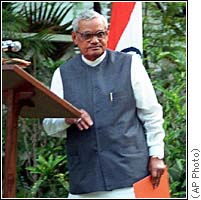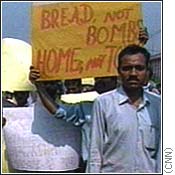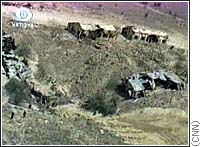|
India's Nuclear Tests News reports and 'eyewitness' accounts Photos courtesy of CNN |
|
May 11 At 6pm (local time, India) on May 11, 1998 the Indian Prime Minister Atal Behari Vajpayee announced the successful completion of India's first nuclear tests since the 'peaceful nuclear test' of 1974. He read the following statement. |

The photograph is Mr Vajpayee announcing the tests. |
|
According to the Times of India earlier in the day the 500 residents of Pokhran, 35km from the 1974 blast were evacuated. The tests were conducted within hours about 3km north of Khetolai, the people of Pokhran felt the earth shake 3 times within 5 seconds. The residents who also observed the 1974 test immediately knew a nuclear test had just been completed. This also came as no surprise as the increase in military activity at the site had significantly increased over the last year.
When the official announcement came that India has successfully undertaken the nuclear tests, the people of Pokhran started dancing with joy in the main bazaar. Celebrations erupted throughout India, evidence of broad popularity of the tests. All political parties announced their support for the tests. The tests resulted in immediate condemnation from around the world. The U.S., Japan and Canada imposed sanctions, other countries withdrew ambassadors and made strong complaints. |
|
May 13 On May 13 India conducted a further two tests. The tests were announced through a press release. From the Times of India: "The sub-kiloton tests, carried out at 12.21 p.m., were of the low-yield variety, meant for weapon calibration." The press release also stated that this completed "the planned series of tests." The tests were also carried out at the Pokhran test site though the local villagers found the news of the tests hard to believe, they had not been evacuated as they had on Monday. From the Times of India: "How could we believe it? There were no tremors, no big noise, no sandstorm. However, some villagers said that after 12.20 p.m. (the time of the second set of blasts), birds started behaving abnormally and flying vigorously in all directions. The birds apparently are most sensitive to such situations. May be they felt the impact,'' said Ranjita Ram, an old villager. |
 Despite the sanctions being imposed by a few nations the general mood remained jubilant. Celebrations were held throughout the country.
Despite the sanctions being imposed by a few nations the general mood remained jubilant. Celebrations were held throughout the country.
|
|
May 16 
Today the first signs of opposition to the tests emerged as 300 anti-nuclear protesters marched through New Deli, joined by members of India's poor low castes, who complained that the government shouldn't be spending money on nuclear weapons when people are starving and dying in the streets. "Before we go nuclear, let us feed the poor," read a sign carried by one protester. |
|
May 17  India's nuclear scientists held a press conference to describe the five tests and release pictures of the test sites. The first blast had a yield of 12 kilotons, the second was a thermonuclear device with a yield of 43 kilotons according to the scientists. The remaining three were all low yield devices, one being detonated on May 11, the remaining two were conducted on a sand dune on May 13.
India's nuclear scientists held a press conference to describe the five tests and release pictures of the test sites. The first blast had a yield of 12 kilotons, the second was a thermonuclear device with a yield of 43 kilotons according to the scientists. The remaining three were all low yield devices, one being detonated on May 11, the remaining two were conducted on a sand dune on May 13.
"The tests... have provided critical data for the validation of our capability in the design of nuclear weapons of different yields for different applications and different delivery systems," Indian scientists said in a statement. |
|
May 26 The U.S. Administration made good on its threat to make India pay for its nuclear tests. Both the U.S. and Japan forced what the World Bank called "an indefinite delay" on US$ 865 million in loans to India. The action is seen as being as much of a warning to Pakistan should it decide to conduct tests, as a punishment for India. |
|
Also check out... [seismic data] [index and links] [Pakistani tests] [The Nuclear Monitor] |